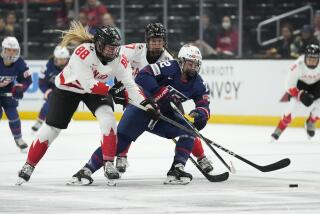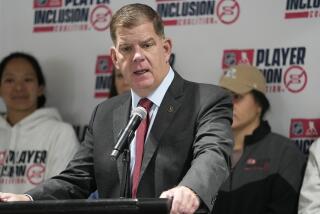Hartford Hopes That Strength in Numbers Will Lead to Cup
- Share via
HARTFORD, Conn. — Depth of personnel is a building block for any sports franchise. Ed Johnston has added this dimension since Richard Gordon, real estate developer and Whalers owner, hired him as architect of Hartford’s hockey future in 1989.
Simply look at training camp for proof: Left wing has been a weak spot. So Johnston crammed 10 bodies into three weeks of fierce competition for four jobs. The rationale is desperation will bring out the best in an athlete. Five quality centers are battling for four spots. Although nobody on the ice will be confused with the guy observing camp from the stands -- advisory board member Bobby Orr -- there also are too many NHL-caliber defensemen for one team.
But any way you slice, dice and rip a hockey team into tiny pieces to put under the microscope for examination, the best athletes determine a viable championship contender. They take a team beyond merely winning a few more games than it loses. The Whalers, 38-33-9 last season with a franchise-best 21-15-4 road record, have already filled the latter suit rather well.
We’re talking about a team with a legitimate shot of winning the Stanley Cup. A team capable of knocking off Boston in the first round, Buffalo in the second, the Rangers in the semis and Calgary or Edmonton for the Cup.
“For the first time in the decade that I’ve been here, I feel like we’ve got a shot at something really special here,” Whalers captain Ron Francis said.
Is Ronnie Franchise engaging in unfounded optimism or, at the very least, a slice of preseason hyperbole?
Maybe.
But maybe not.
Only Calgary, Edmonton and Buffalo are definitely better on paper. Boston and Chicago can make excellent arguments, too. But Montreal, the Rangers, St. Louis, New Jersey? Maybe. Maybe not.
If you sit down and really consider the situation, only five players possibly could be named the Whalers’ outstanding player in pregame ceremonies March 30.
Francis.
Pat Verbeek.
Ulf Samuelsson.
Kevin Dineen.
The starting goalie, presumably Peter Sidorkiewicz.
These are the five who will determine how far the Whalers will rise -- or sink.
Bobby Holik? He’s 6-foot-4, 210 pounds. He’s a monster. He may do a splendid job adjusting to the NHL. But even more important than his height and weight is his age: 19. And his nationality: Czech. He’s got to mature into his body. He’s got to adapt to a new life and new league.
Bobby Holik? An excellent choice for MVP in 1993. But not this season. Even Johnston says if Holik is the team’s best player this time around, “Then he’s either an unbelievable rookie performer -- or the other guys dropped.”
Each of those five potential MVPs is a story. And there is one more story in a name missing from that list.
Pat Verbeek represents exactly what coach Rick Ley demands from his players. Grit. Grit. And more grit. Maybe when you get your thumb chopped off in a farming accident and are fortunate enough for successful surgical reattachment, you don’t take anything in life for granted.
Can Verbeek top last season’s 44 goals? Perhaps not, but he doesn’t figure to go south in terms of effort, either. He’s getting $280,000 this season. A big year will send him to the bargaining table in excellent shape next summer when his option comes up.
As a rookie NHL coach, Rick Ley was not afraid to speak out last season. That “110 percent effort, 100 percent of the time” motto of Ley’s may have sounded like a coaching cliche, but he meant it. And everybody from Brian Lawton to Jody Hull to Ray Ferraro to Scott Young and, yes, Dineen felt the whip. Soft Sylvain Turegon never even made it to camp.
And when Ley, citing some crybaby attitudes on the club, said after the Whalers’ seventh-game loss in Boston, “If they thought I was tough on them this year, now that I know them. ...” You couldn’t help but believe his threat.
Kay Whitmore’s future has been inflated to star status, but his present leaves so much to prove. Daryl Reaugh gave him a scare at training camp. Until proven otherwise, Sidorkiewicz is No. 1.
Goalkeeping is the game’s most important position. And any No. 1 goalie is vitally important to a team’s success, especially in the spring. By virtue of his position, he alternately will be thrust into the spotlight as goat or hero. It’s a constant, damning pressure a goalie must accept.
How good is Sidorkiewicz? Good, sometimes very good. He is no slouch. But not great, either. Buffalo’s Daren Puppa, Montreal’s Patrick Roy and Boston’s Andy Moog are better. They are three reasons why the Whalers may not make it out of the Adams Division.
Good goaltending can save a team some nights and not others. Great goaltending -- as Edmonton got from Bill Ranford last spring -- wins the Stanley Cup.
A goalkeeper’s numbers inevitably are only as impressive as the defense and the defensive system in front of him.
It’s important for a team to be best or nearly the best in something. The Whalers’ 21-15-4 road mark, second in the NHL only to Boston, served as a rallying point.
The Whalers also dropped from 290 goals against (ninth in the NHL) under Larry Pleau to 268. That’s more in line with the totals of 1987 (270) and 1988 (267). The Whalers also were fourth in the NHL in penalty-killing at 81.5 percent. While improving their offense, the Whalers must be at least as good defensively as last season. Better if they want to be champions.
By trading Chris Chelios and Craig Ludwig in 1990 and losing Larry Robinson and Rick Green in 1989, the Canadiens (Jennings Trophy winners three of the past four years) are virtually guaranteed of giving up more than last year’s 234 goals. But Boston (No. 1 at 232) and Buffalo (No. 3 at 248) will be equally stingy.
Johnston is putting a premium on an improved transition game. And, surely, this is important. But Samuelsson also must solidify the penalty-killing and be strong and aggressive around the net -- yet still be disciplined. More than a year after knee surgery, he should be ready to return to his glory days of 1987. Samuelsson is no Ray Bourque in the offensive end and through the neutral zone. He must remember this. But he can be a Bourque in the defensive end.
Can Dineen, who dropped from 45 to 25 goals last year, live happily ever after with Ley? Or will he march to his own drummer and promptly march right out of town?
A graph of Dineen’s career is starting to look like Mount Everest followed by Death Valley followed by Mount Everest followed by Death Valley.
Dineen’s health, because of Crohn’s Disease and because his reckless style leads to shoulder and knee injuries, is a constant source of concern.
But the way he handles the highs and lows is also vital to the Whalers’ success. With Verbeek, Dineen and Young, the Whalers can punch 1-2-3 for 100 to 110 goals on the right side.
While it would be terribly unfair to file Ley’s relationship with Dineen in the same drawer as Mike Keenan’s with Denis Savard in Chicago, it also would be untrue Ley worshipped at Dineen’s altar.
Standing at the luggage carousel at the Vancouver airport Jan.7 -- after benching Dineen in Calgary a few nights earlier -- Ley said: “They have only been a handful of games Kevin has played well in this year. When he’s got the puck nobody in hockey works any harder. But Kevin’s not playing with that same sort of concentration without the puck. His mind wanders.
“We have meetings. And he goes out in a game like Calgary and was lost out there. He doesn’t always pay attention to what is said.”
Those were angry words. But coming into camp, both say the air long has been cleared.
“What bothers me about it is that Kevin and I had one problem where I wasn’t happy with his play and he wasn’t happy about being benched,” Ley said. “And people blow it up. There is no long-term problem.
“I think Kevin would be the first to tell you he didn’t have as good a year as he wanted. I’m quite sure he’ll bounce back. Absolutely, things got better between us after we talked. You just can’t go out there with reckless abandon.”
Said Dineen: “And I don’t think I was being shopped around nearly as much as things were made out to be during the summer. OK. The Winnipeg thing (in the bid for Dale Hawerchuk), but I think others were overblown. I want to be here.”
But if Dineen and the Whalers defense don’t start fast, don’t be shocked if his $500,000 a year salary is cleared to make way for a quarterback defenseman.
Ron Francis is the rock. Maybe Ferraro will catch fire again as he did when he scored 41 goals in 1988-89. Maybe Carey Wilson is so thrilled about getting another chance in Hartford that he will, as Ley pledged, “be the greatest thing since the invention of bubble gum.” Maybe Holik is the next Peter Stastny.
Unless injuries force him to miss more than 10 games, Francis is guaranteed to lead the team in scoring. It’s been that way every year since 1983-84.
More than Gordon, more than Johnston, Ley, Dineen or anybody else, the Whalers are Ron Francis.
That’s why his contract status will be a variable to watch. If he plays out his option at $370,000 while other big NHL names sign for $750,000 and far more this year, he may play great to spite, or at least show, management. And then he’ll collect at the free-agent window next summer. Or Francis could be affected adversely. At the very least, Francis’ previously unflinching loyalty may be threatened.
And if enough quality depth surrounds Francis and he still can’t lead the Whalers next spring to their first playoff-round victory in five years, management may feel they have obtained a verdict on his net worth: Even if Francis scores 1,000 points in his Whalers career, he is a solid, consistent star on both ends of the ice. But not the dynamo to lead them to, in Francis’ words, “something special.”
After his club finished 19th in offense (275 goals), which in turn helped make the Whalers only the third team in NHL history to finish above .500 on the road and under .500 at home, Johnston identified the problem: too little punch from the point. He promptly announced in April he would pursue a trade for a top-flight offensive defenseman. From Pittsburgh’s Zarley Zalapski to Winnipeg’s Dave Ellett, the rumors flew. Even as the Whalers completed training camp, the rumors were flying.
Dave Babych is still wearing No. 44. And memories of these disastrous power-play numbers: 3-for-34 in the playoffs, including 1-for-23 (and it was a late, meaningless goal in Game 7) in the Boston Garden are all too fresh.
Young is still being moved back from right wing to the point to make use of his oft-wild slapshot. Brad Shaw has a deft touch for moving the puck, especially out of the defensive end, but he isn’t the big clout the Whalers still need. Jergus Baca has turned out to be a bolt of offensive juice, but the rookie blunders and needs time to adjust to the NHL decision-making process. When to take a chance and when not to take a chance are still new English questions to the Slovak.
More to Read
Go beyond the scoreboard
Get the latest on L.A.'s teams in the daily Sports Report newsletter.
You may occasionally receive promotional content from the Los Angeles Times.






